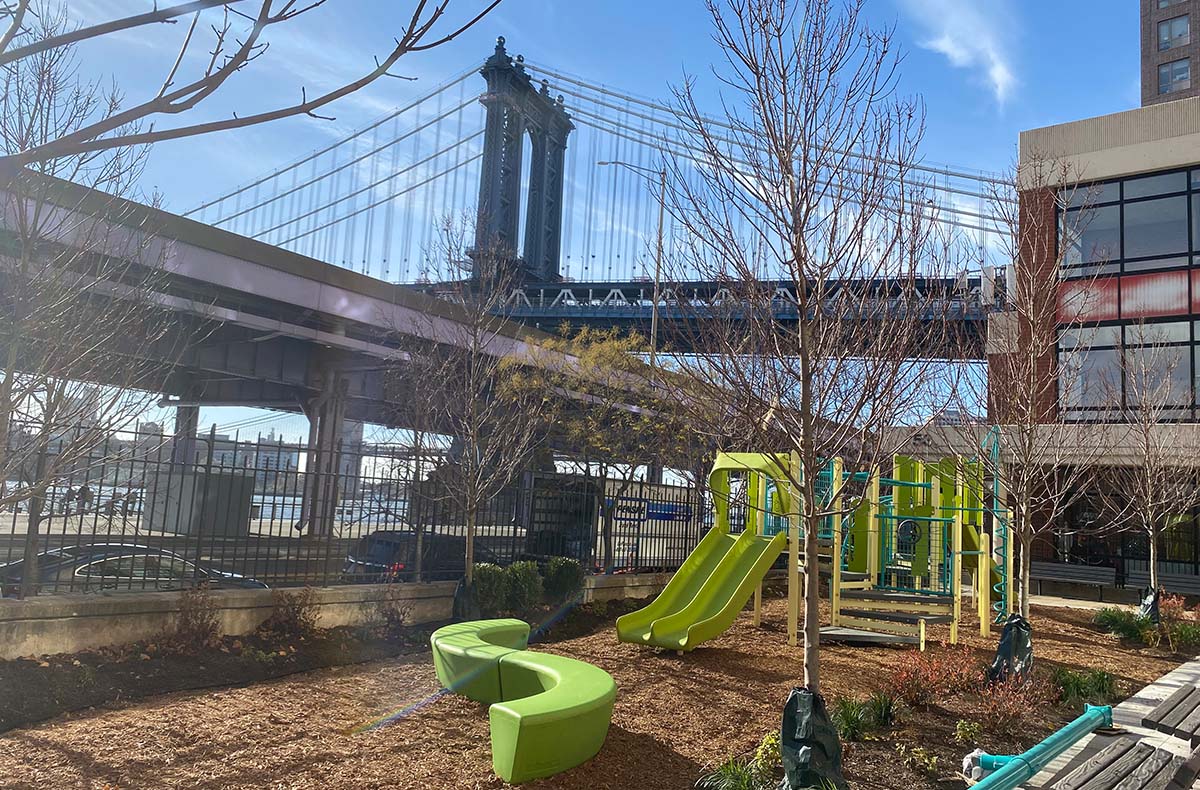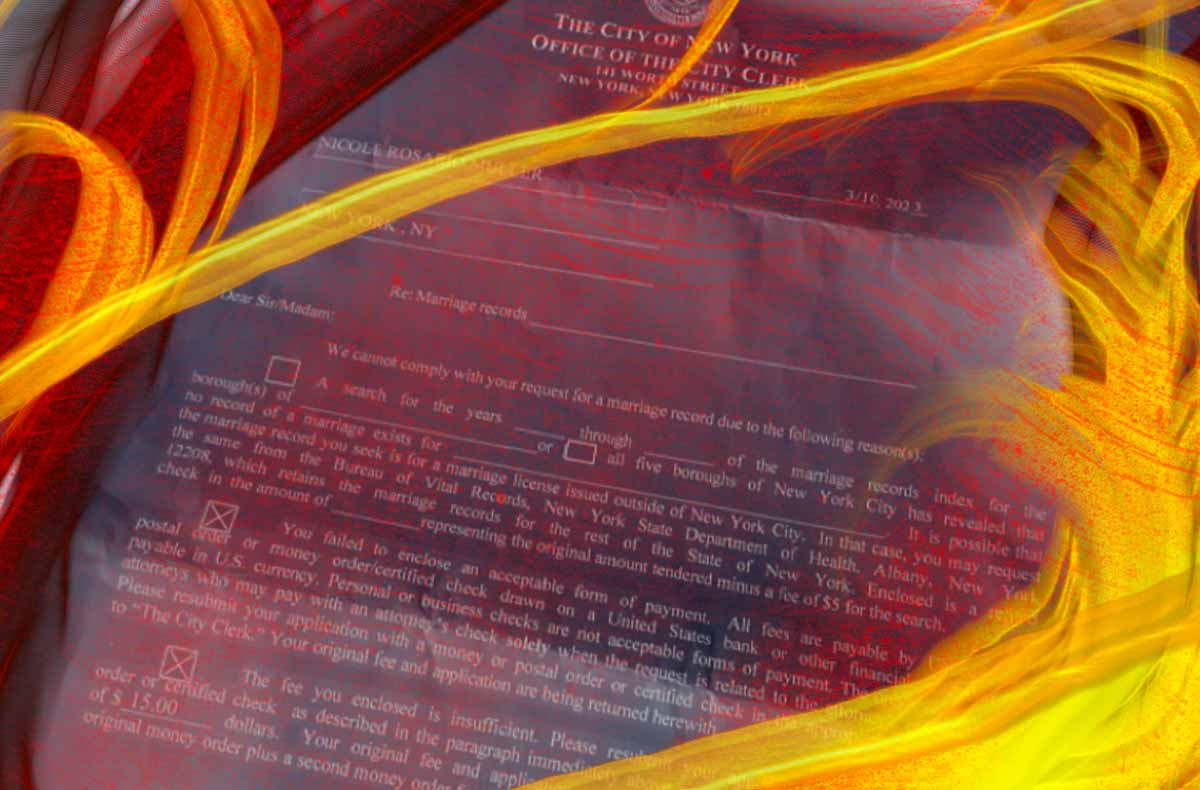
On an appropriately rainy April 6th on Manhattan’s Lower East Side, the Two Bridges Neighborhood Council and Settlement Housing Fund proudly celebrated the opening of the neighborhood’s first rain garden at 82 Rutgers Slip. Work on the project began in 2013, thanks to a Green Infrastructure Grant from the NYC Department of Environmental Protection, granted to improve the green infrastructure of Two Bridges Tower, which offers affordable housing.
The garden was designed by DLANDstudio, which, led by founding principal Susannah C. Drake, FASLA, AIA, has been a pioneer for innovative, socially-conscious green infrastructure. It serves a dual purpose: to offer a new green space for the local community to enjoy while improving the waterfront’s resiliency. The plants within the garden absorb rainfall, keeping it from entering storm drains and reducing the likelihood of flooding, while also helping to remove pollutants from the air and providing a cool “microclimate” of ample shade for residents to enjoy.
This is just one of many such projects the city’s DEP has funded, and comes not a moment too soon, with New York’s waterfront getting routinely battered by increasingly extreme weather events. Since Hurricane Sandy, the city has been acutely aware of the coastline’s vulnerability, which has led to the enactment of the biggest resiliency program in the United States. At the beginning of this year, in fact, the New York City Economic Development Corporation (NYCEDC) and Mayor’s Office of Climate Resiliency (MOCR) announced the Financial District and Seaport Climate Resilience Master Plan, a $5-7 billion plan aiming to protect the Lower Manhattan waterfront rising sea levels and future storms.
But as important as it is to prepare the island of Manhattan for further fallout from climate change, there’s a greater issue of “green gentrification” that gives many native New Yorkers pause. When Sandy first struck in 2012, those in low income housing were especially hard hit. According to the NRDC, “approximately 80,000 public housing residents in 402 NYCHA buildings lost power, heat, and hot water,” with many of the buildings remaining without power “until more than 2 weeks after the storm.” Protecting these communities from future disruption is essential, but such greening efforts must be executed with social justice in mind. Basically, we need to ensure that vulnerable, low income populations—which, as Sandy illustrated, are already more likely to have been negatively impacted by climate change—don’t wind up being displaced from their homes when greening efforts attract wealthy would-be renters eager to benefit from the neighborhood’s new upgrades.
The intersectionality of environmentalism with social justice lies at the heart of critical sustainability. As outlined by UCSC’s Critical Sustainabilities project, “sustainability [commonly] rests on a core idea, first articulated in the United Nations’ 1987 Brundtland Commission Report, Our Common Future, of ‘meeting today’s needs without compromising the ability of future generations to meet their own needs,’ and doing so by balancing the ‘three E’s’ of equity, ecology, and economy.” When thinking about sustainability, we tend to jump to the second “E”—ecology—but it’s vital that those other two “E’s” are addressed simultaneously to move towards a better future benefiting everyone equally—not just those born lucky.
Green resiliency efforts in New York predictably come up against issues of equity, and it’s not just a matter of money, but another resource: time. With billions of dollars going towards resiliency projects, it’s crucial that these efforts be realized at a local level while taking into account the wishes of those who presently live in these locations. However, a large part of how community efforts take shape is determined through local governance by those who show up.
Trever Holland—the Resident Association President at Two Bridges Tower, Community Board Three Parks chair, and “hat-wearer” for numerous other community organizations, described how the slow-turning wheels of local government is something not many people have time or stomach for—especially those in the communities where it matters most. A wealthier neighborhood with retired doctors and lawyers is far more likely to have well-attended community board meetings, where people volunteer the extra time they have on their hands. Conversely, it’s difficult to ask people to show up for marathon meetings in a basement after a full day of work and caring for their kids and family.
As Holland describes, “I’ve learned that people want to get involved until they get involved. People will come to their first three hour board meeting in a windowless basement, and I’ll ask, ‘You going to come to the next one at 6:30?’ And they’ll ask, ‘is it three hours long?’ ‘Yes.’ And then you never see them again.”
Holland himself found his way into community organizing incidentally: what started as him simply trying to figure out why idling buses were fumigating his neighborhood with diesel fumes turned into nearly two decades of community leadership, which Holland describes as “more challenging than anything he’s done in his professional life.” (While not currently practicing, Holland is an attorney by trade, so this is especially noteworthy.)
In spite of the challenges he’s faced, Holland knows that, to ensure that local changes are happening that reflect the wishes of a community, it’s crucial someone from their ranks be “in the room.” This is what has kept Holland coming back time and again: the need to represent those of his community who cannot (or will not) be present. While few people are eager to get home after 11PM three days in a row—Holland himself included—he notes how “a lot of these critical decisions were made at 9PM in a basement by four people. Why’s the FDR overpass purple? Well, we had a three-hour meeting this Friday, and this was what we decided.” Those who are present make the decisions—so Holland gives up a lot of his weeknights and vacation time to make sure the people who live in his area have a voice.
Right now, there is a lot of money coming into lower income neighborhoods that have traditionally been overlooked. The $1.45 billion East Side Coastal Resiliency Project (ESCR) marks an unprecedented, historic investment in such communities, so it’s important that we get it right. First, to encourage local support of such efforts, current residents need to be reassured their housing is stable. If people feel like their rent is going to go up and force them out, they don’t care if you’re “making the neighborhood nicer.” As Holland notes, “If we want resiliency but we’re afraid of gentrification, then we wind up with horrible neighborhoods that flood in the next storm. We need to make it work and make it nice, but we also need to make sure people can stay in their homes.”
Additionally, resiliency efforts need to preserve the essential local character of a neighborhood so that locals don’t end up thinking, “this park is not for me anymore.” This requires listening to people, taking feedback and implementing their wishes. For example, if people love to barbecue, there had better be new grills for use in your shiny, updated park. Holland notes that the city’s done “a great job of extensive outreach in asking what people want”—ensuring that it’s not just the four people in the room that benefit from this nearly $2 billion upgrade, but all locals.
The recently-opened rain garden is precisely the kind of project Holland hopes to see more of. Its creation actively involved feedback from the residents of Two Bridges Tower, ensuring that the outcome would be something familiar and welcome, and its design phase was leveraged as an educational opportunity for local kids in an afterschool STEM program to learn about climate change and microclimates. Holland hopes the garden can serve as “a neighborhood model for how green infrastructure can provide many benefits to the community, including stormwater management, improved air quality, improved recreational amenities for residents, and environmental education programming.”
While Covid slowed down progress considerably, Holland remains hopeful that he’ll see the two major resiliency projects in his neighborhood realized within the next decade, so he might be able to get his evenings back again. Until then, he’ll keep doing his part to keep things moving forward, hopeful that someone from the next generation will take over his role when these jobs are done. There will always be more work to do, especially when it comes to ensuring environmental justice on a local level. In Holland’s words, “city government works at a very slow, mechanical pace and breaks often. You have to learn how to fix it and how to grease it. I tip my hat to anyone who gets involved.”



